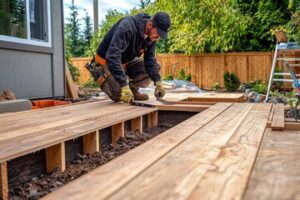Electrical work is a great career for those who need to use their hands and think on their feet. It also provides a good living without the college debt that some other careers require.
Almost every home and building has an electrical power, communication, lighting, and control system that needs to be maintained and upgraded. Contact Electrician Tampa now!

Whether you want to be an electrician or you’re already one, there are specific requirements that you need to meet. These include training and education, practical experience, and specialized skills. In addition, you need to adhere to local and state electrical regulations.
You can complete an apprenticeship program or enroll in a trade school to receive the necessary training. Both options are great ways to learn the skills needed to become a licensed electrician. You can also take a short course in a particular facet of electrical work, such as solar energy or fire alarm systems. This enables you to specialize in your area of choice, which will increase your job prospects.
Electricians who work with residential and commercial customers perform a variety of tasks related to electrical installation and repair. This can include installing lighting, power outlets, conduits, cable trays and ladder racks. They also inspect, test and maintain electrical equipment. This work requires good hand-eye coordination and physical strength, as well as the ability to read blueprints and technical documents.
Master electricians have extensive knowledge of the National Electrical Code. These professionals have completed a trade school or apprenticeship program and passed an exam to become certified. They are responsible for the installation and repair of wiring in homes, commercial buildings, and industrial facilities. Master electricians often supervise other electricians and may be called upon to help resolve complex problems.
Apprentices and other entry-level electricians typically require a high school diploma or equivalent. Some also participate in an apprenticeship program lasting four or five years to gain on-the-job experience. The apprenticeship program teaches them the fundamentals of electrical work and provides them with hands-on instruction. These programs are available at most vocational schools and technical colleges.
In addition to technical skills, electricians need to have a number of other qualities, including a strong work ethic, attention to detail and excellent communication skills. They must be able to work as part of a team, but they must be self-sufficient as well. They must be able to understand technical plans and diagrams, and they must have a good grasp of math to decipher the calculations involved in their jobs. They must also have a keen eye for detail to spot potential safety issues and have the patience to correct them.
Training
Electricians need to have good problem-solving skills to fix electrical problems. These skills can be learned through on-the-job training and through classroom learning. The best way to gain these skills is through an apprenticeship, which allows electricians to work with experienced professionals while earning a wage and working toward a license.
A degree in electrical technology can provide a broad understanding of the theory behind electrical work. This may include circuitry, systems design, and safety practices. It can also help electricians develop specialized knowledge in areas like renewable energy and smart grid technology, and it can prepare them for leadership roles.
Many aspiring electricians choose to attend trade schools, which offer hands-on training in residential and commercial wiring and other electrical techniques. These programs often take a few years to complete and can be a stepping stone to an apprenticeship. In addition to offering hands-on training, many trade schools have connections with local employers and can help students find employment after graduation.
Some electricians may also pursue professional certification to boost their resume and improve their job prospects. Professional certifications are available for both residential and commercial electricians, and can be obtained through online courses or in-person classes. In-person classes typically require a fee, but can be more comprehensive than online learning.
The JATC offers electrician education through a state-of-the-art training facility and classrooms stocked with the finest equipment. Our highly knowledgeable Enrollment Specialists are here to answer any questions you might have about our programs.
The electrical industry is facing several challenges, including the aging of skilled electricians and a shortage of young workers. The JATC is committed to meeting these challenges through innovative programs and partnerships with community organizations. We’re proud to be a leading provider of quality training for aspiring electricians in the Greater Boston area.
Job duties
The job duties of an electrician focus on the installation, repair, and maintenance of electrical wiring and equipment. They also test the continuity of circuits in wires, cables, and fixtures based on building codes and specifications. They work with sketches or blueprints to determine the location of wires and systems and ensure that they are installed in accordance with governing regulations. They are skilled in the use of power tools and other testing equipment, including ohmmeters, voltmeters, and oscilloscopes.
A licensed electrician may choose to specialize in one of many areas of the field, from commercial wiring to residential work. These electricians are typically paid higher wages, as well as a range of additional benefits. For example, some may offer a flexible schedule, or free labor to replace damaged components. These perks can help attract and retain top talent, and they can be an effective way to differentiate your company from its competition.
Regardless of their specialization, all electricians must be proficient in a number of skills. These include the ability to work with power tools, a strong understanding of electrical theory and design, and excellent analytical and problem-solving abilities. They also must be able to read and interpret blueprints, which are a vital part of the work. Additionally, they must be familiar with the latest technology in the electrical industry and be able to handle high voltages.
In addition to these qualifications, electricians must have a good working knowledge of local and national building and safety codes. They also need to be able to effectively communicate with customers and supervisors. This includes being able to answer questions, explain complex electrical systems, and address problems with existing equipment. Finally, they must be able to follow instructions from supervisors and other employees.
Creating a compelling electrician job description can help you attract qualified candidates, accelerate the hiring process, and expand your team. The job description should highlight the responsibilities, qualifications, and salary of your open position. You can also include details about the work environment and benefits. For instance, if your company offers competitive pay rates or has won regional or national awards for safety and efficiency, be sure to include these details in the description. Finally, make sure the job description describes what sets your company apart from its competitors. For example, you can mention that your company is a leader in green technologies or offers a variety of service options to meet different customer needs. This will encourage your potential applicants to contact you to learn more about the job and to see if it’s a fit for them.
Employment outlook
There are many jobs out there for people interested in becoming electricians. The employment outlook for this field is positive and is expected to grow faster than the average for all occupations. This is due to a number of factors, including increases in construction spending and the demand for alternative energy sources, which will require electricians to install and repair these systems.
In addition, aging electrical infrastructure and the need to comply with new building codes will also create job opportunities for electricians. These trends are helping to fuel the growth of the electrical services industry, which is projected to increase by 9% over the next decade.
The demand for electricians fluctuates with the overall economy. It is usually higher during periods of construction or maintenance, and may be lower during slower times. Some electricians choose to specialize, which can help them find more work. Others seek out apprenticeships to learn the trade and gain hands-on experience.
Those who want to become electricians should begin by getting a high school diploma or equivalent. There are many vocational schools and community colleges that offer programs designed to train future electricians. These programs typically combine classroom instruction with on-the-job training under the supervision of a master electrician.
After completing the program, apprentices must pass a background check and drug test before being licensed by their state. Licensing requirements vary by state, but most states have similar qualifications. The minimum requirement for licensure is a high school diploma and 2,000 hours of paid on-the-job training.
Electricians perform a variety of duties, including laying out and running wiring, testing and repairing electrical equipment, and ensuring conformance to all relevant safety codes. They also read blueprints to determine the location of electrical wiring and fixtures. They use various hand and power tools, such as screwdrivers, conduit benders, and wire strippers, to perform their tasks. They also install ground leads and connect power cables to equipment, such as motors.
Almost all buildings require electrical power, communication, lighting, and control systems. These systems are installed during construction and maintained afterward to provide power for lights, appliances, and equipment. There are many different sectors that employ electricians, and the type of sector you choose to work in will impact your salary.








